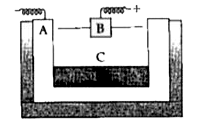The method of electrolytic refining is not suitable in the extraction of
Aluminium
Copper
Mercury
Silver
The correct Answer is:C
To determine which metal is not suitable for extraction using the method of electrolytic refining, let's analyze the options provided:
Step 1: Understand Electrolytic Refining
Electrolytic refining is a process used to purify metals. It is particularly effective for extracting metals that are more reactive. During this process, an impure metal is made the anode, and a pure metal is deposited at the cathode.
Step 2: Analyze the Options
1. Aluminium: This is a highly reactive metal. Electrolytic refining is suitable for aluminium extraction.
2. Copper: Copper is also suitable for electrolytic refining as it is a moderately reactive metal.
3. Mercury: Mercury is a less reactive metal and is typically extracted using self-reduction methods rather than electrolytic refining.
4. Silver: Silver is a precious metal that can be extracted using electrolytic refining.
Step 3: Conclusion
Based on the analysis, the method of electrolytic refining is not suitable for the extraction of Mercury.
Final Answer
The correct option is 3. Mercury.
---
Electrolytic refining is a process used to purify metals. It is particularly effective for extracting metals that are more reactive. During this process, an impure metal is made the anode, and a pure metal is deposited at the cathode.
1. Aluminium: This is a highly reactive metal. Electrolytic refining is suitable for aluminium extraction.
2. Copper: Copper is also suitable for electrolytic refining as it is a moderately reactive metal.
3. Mercury: Mercury is a less reactive metal and is typically extracted using self-reduction methods rather than electrolytic refining.
4. Silver: Silver is a precious metal that can be extracted using electrolytic refining.
Based on the analysis, the method of electrolytic refining is not suitable for the extraction of Mercury.
The correct option is 3. Mercury.
Topper's Solved these Questions
- METALLURGYBOOK - VK JAISWAL ENGLISHCHAPTER - METALLURGYEXERCISE - Level 3 (Passive 1)
8 Videos
- METALLURGYBOOK - VK JAISWAL ENGLISHCHAPTER - METALLURGYEXERCISE - Level 3 (Passive 2)
6 Videos
- METALLURGYBOOK - VK JAISWAL ENGLISHCHAPTER - METALLURGYEXERCISE - ASSERTION-REASON TYPE QUESTIONS
29 Videos
- ENVIRONMENTAL CHEMISTRYBOOK - VK JAISWAL ENGLISHCHAPTER - ENVIRONMENTAL CHEMISTRYEXERCISE - ASSERTION-REASON TYPE QUESTIONS
14 Videos
- p-BLOCK ELEMENTSBOOK - VK JAISWAL ENGLISHCHAPTER - p-BLOCK ELEMENTSEXERCISE - SUBJECTIVE PROBLEMS
35 Videos
Similar Questions
In the electrolytic refining of Cu
View SolutionElectrolytic reduction method is used for the extraction of
View SolutionElectrolytic reduction method is used fro the extraction of
View Solution(a) Write the principle of electrolytic refining.
(b) Why does copper obtained in the extraction from copper pyrites have a blistered appearance?
(c) What is the role of depressants in the froth floatation process?
View SolutionExplain the principle of the method electrolytic refining of metal. Given one example.
View SolutionDuring electrolytic refining of zinc, it gets
View SolutionFollowing is the sketch of electrolytic cell used in the extraction of aluminium :
Name the ore used in extraction of aluminium .

View SolutionIn electrolytic refining, the impure metal is made
View SolutionThe alongside figure is of an electrolytic cell used in the extraction of aluminium.
What are the two aluminium compounds in the electrolyte C?
View SolutionDescribe the principle involved in each of the following processes of metallurgy :
(i) Froth floatation method
(ii) Electrolytic refining of metals
(iii) Zone refining of metals
View Solution
